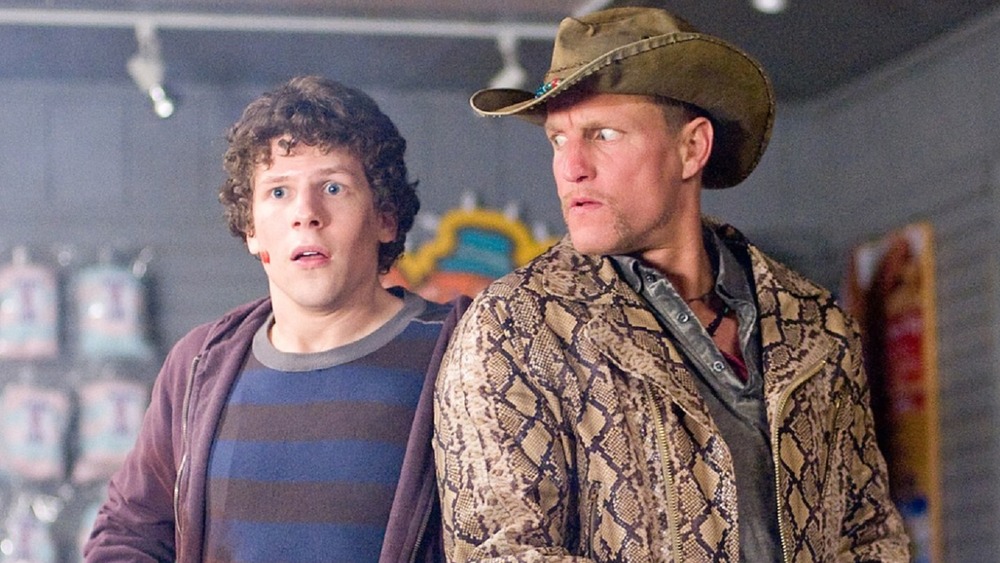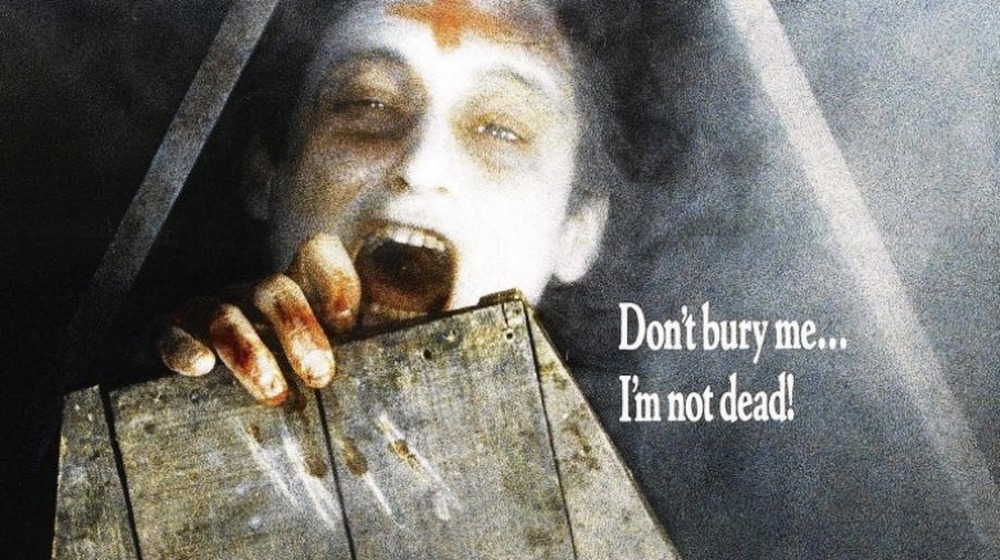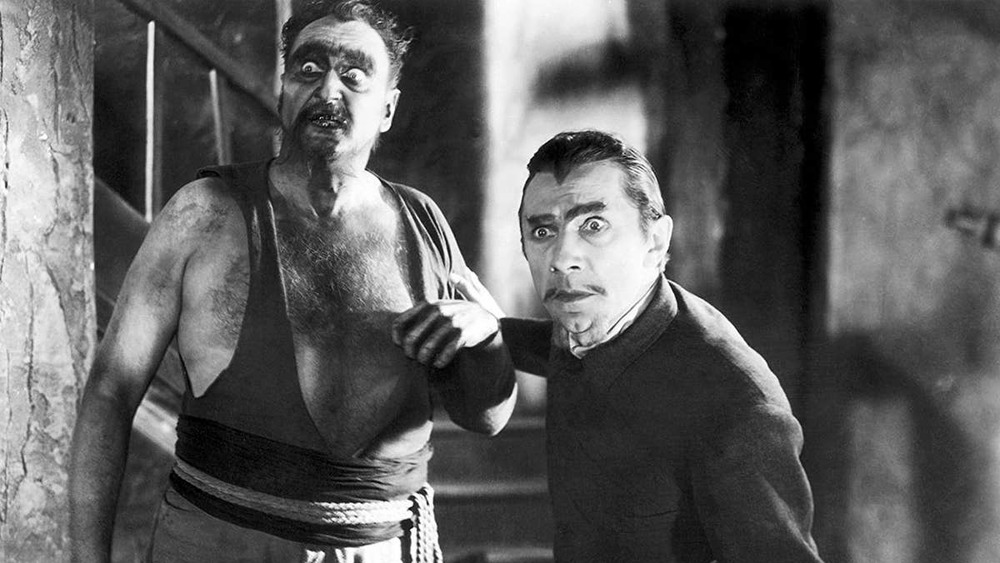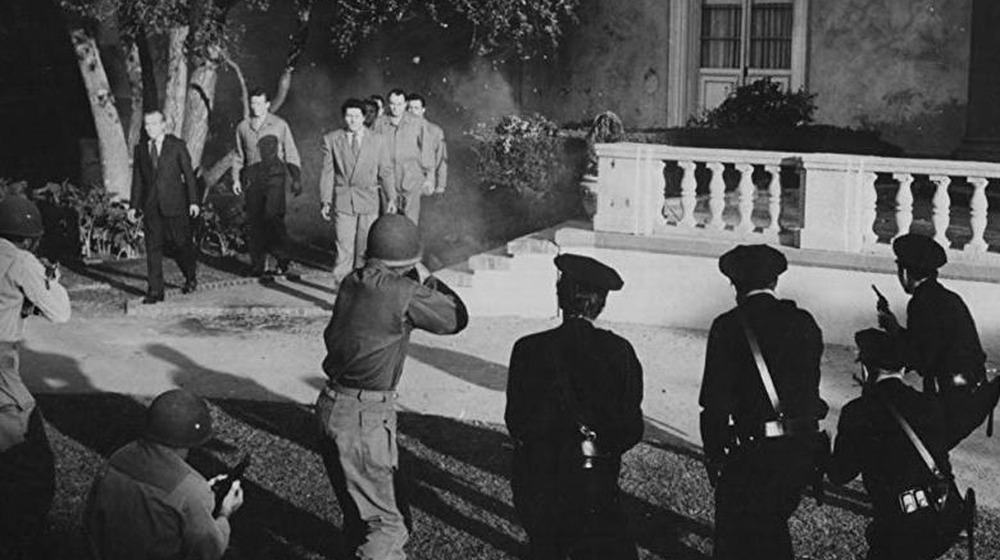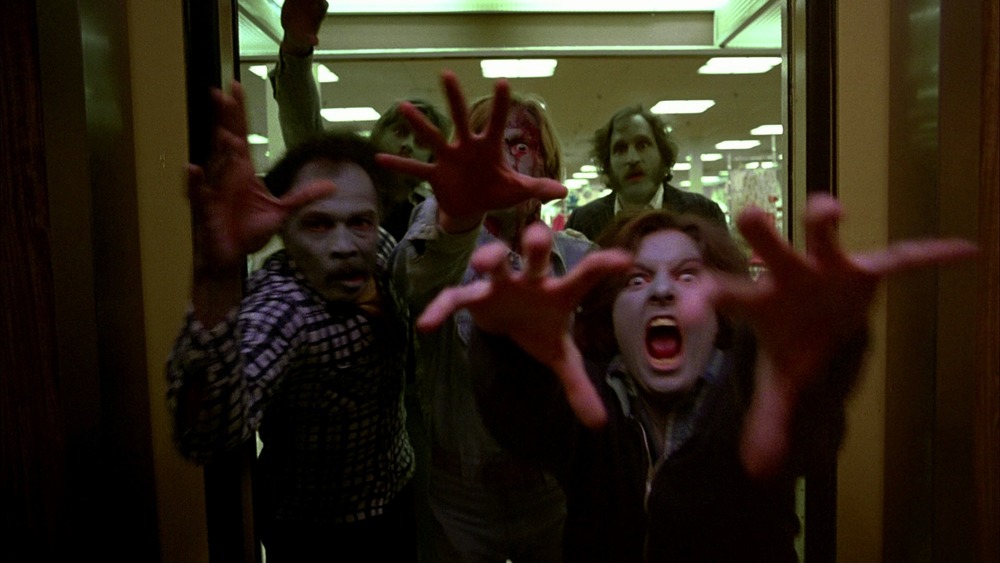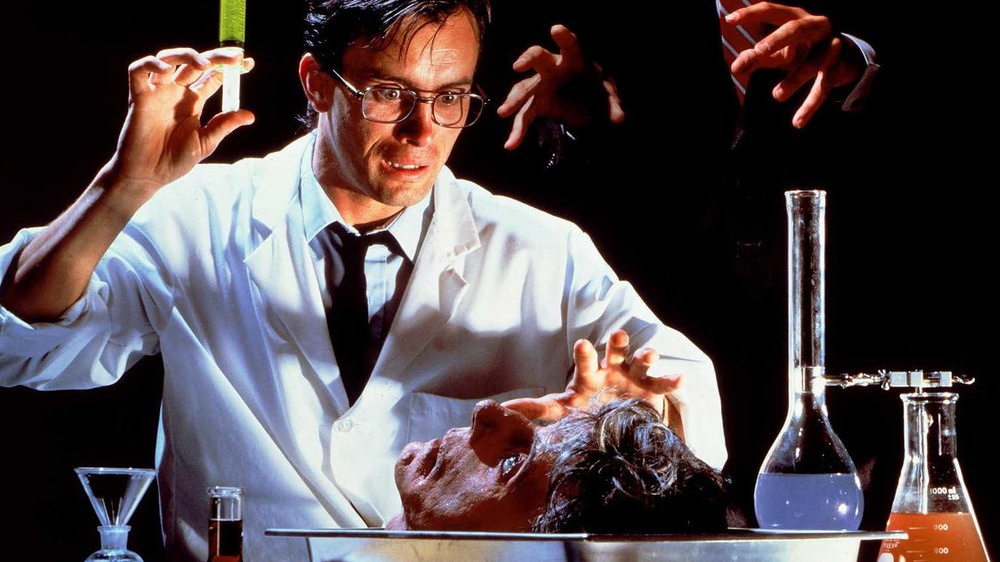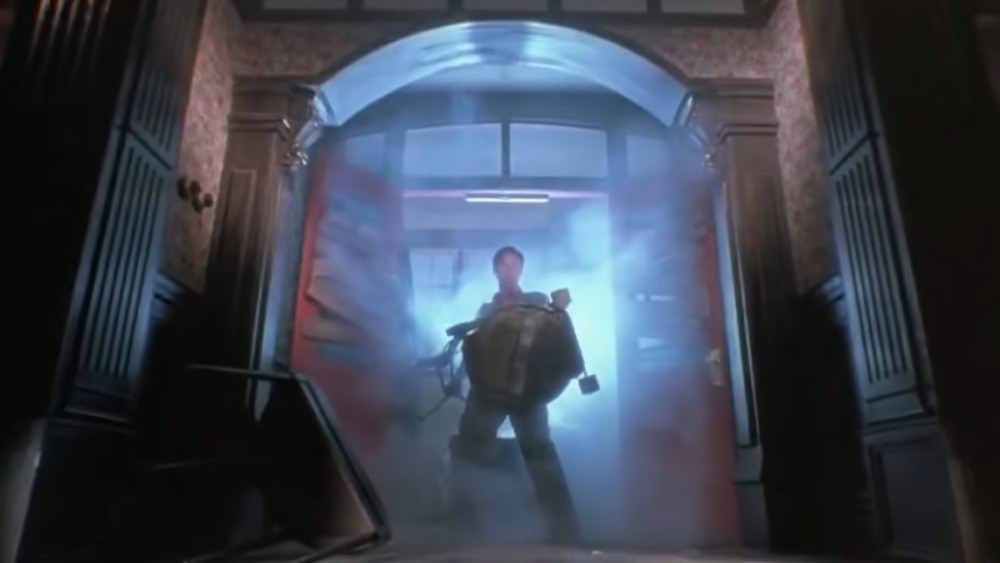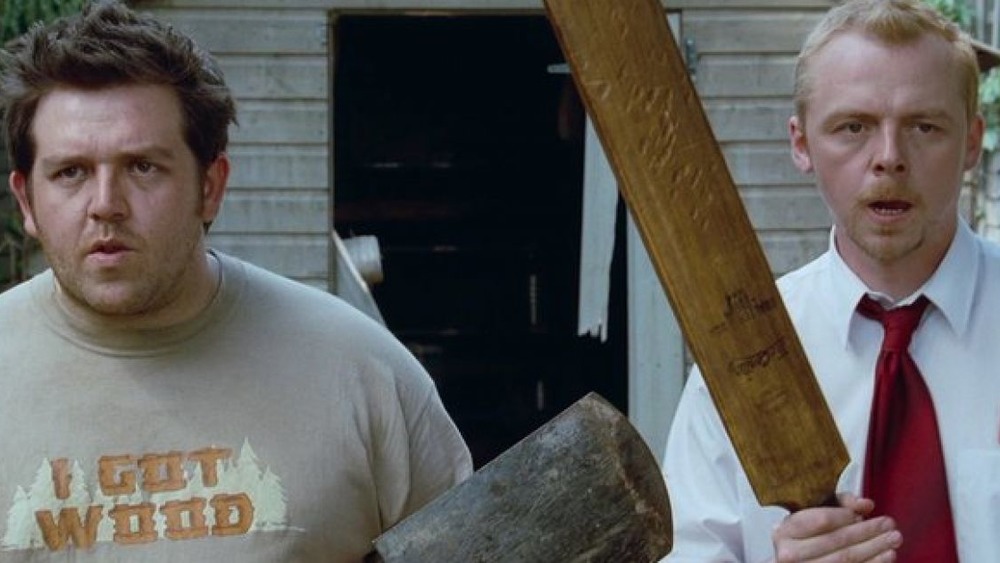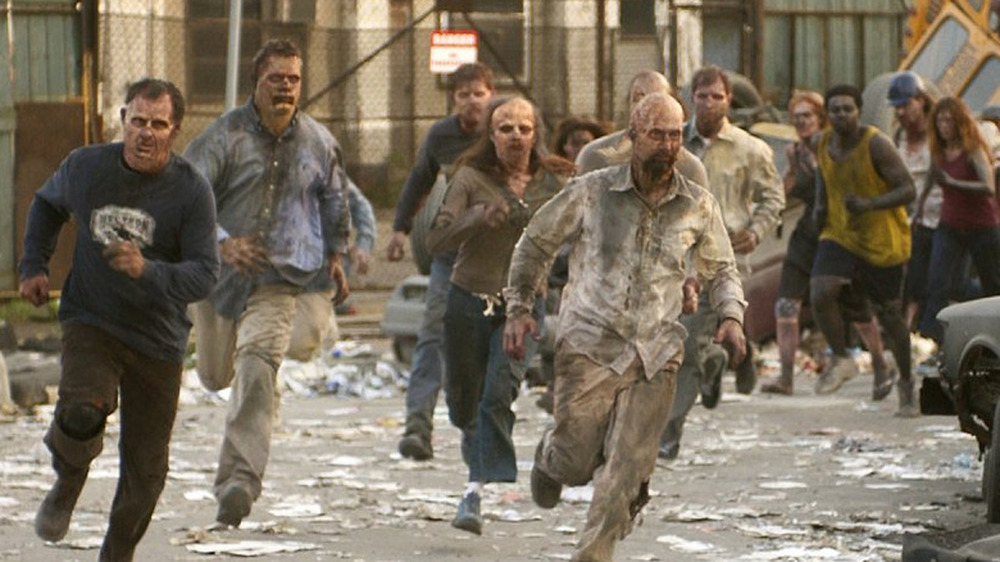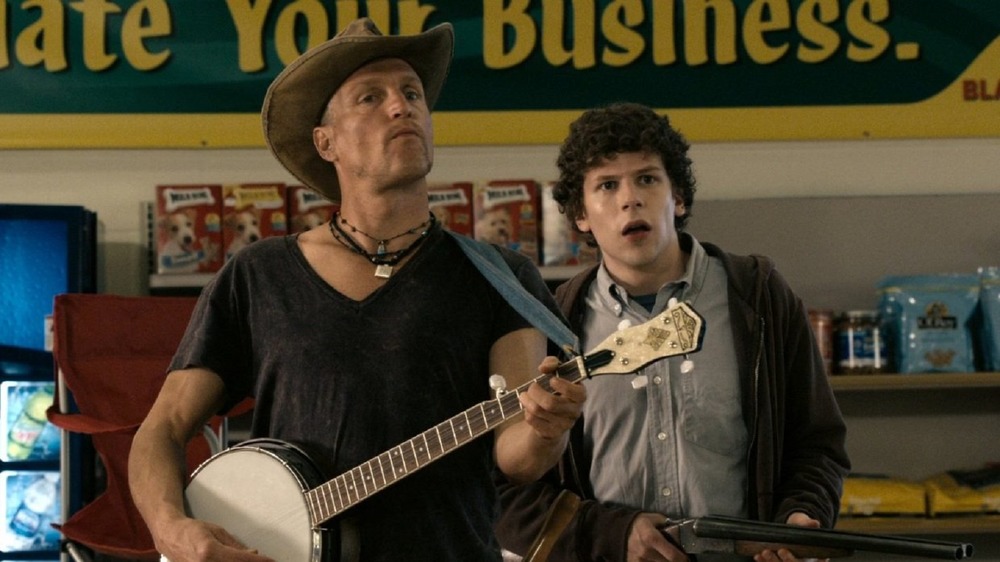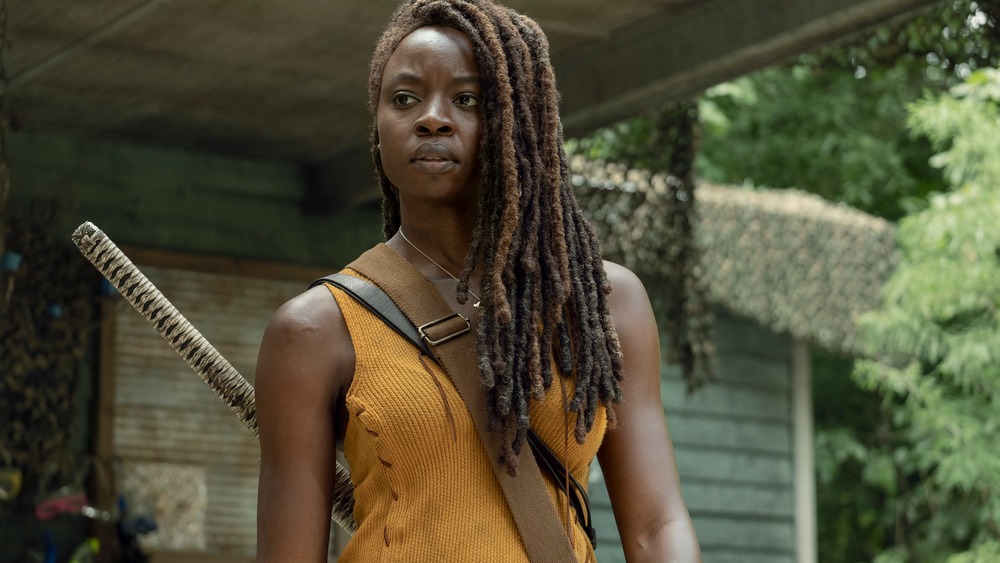How To Kill Zombies According To Hollywood
Zombies have been stumbling around movie screens for quite some time, and we all know what they want — delicious, succulent brains. Or really, any body part will work. For the most part, zombies aren't picky eaters.
Needless to say, most movie characters want to hang on to all their limbs and organs, so how do they go about defending themselves? Well, everybody knows that when it comes to fighting the undead, it's all about aiming for the head.
At first, you might think Hollywood adhering to the head trauma principle might be a bit restrictive when it comes to creative kills. However, this particular approach has allowed filmmakers to deliver the gruesome special effects on which the zombie genre has earned a worldwide fanbase. There are a lot of ways to "kill the brain," as a newsman in Night of the Living Dead explains, and just about every method has made its way to the screen.
So, for your horrific pleasure, we've assembled a list of the most creative zombie kills in both film and TV. From animal attacks to murder involving machinery, here's how to slaughter zombies according to Hollywood. (Warning — spoilers below.)
Zombie-killing, Vodou-style
Before we get too far into some undead destruction, we've got to ask, how do you make a zombie? Well, in current films and TV shows, it's usually weird science, like a virus outbreak, that reanimates the dead. But in the traditional folklore of Haiti and the Caribbean, you can have your very own zombie by enlisting the aid of a Vodou practitioner, also known as a bokor. Legend and literature suggests that the bokor can revive and bind a corpse to their will through magic or by capturing its soul in a bottle.
However, in his book The Serpent and the Rainbow, ethnobotanist Wade Davis makes a case for neurotoxins, some derived from the puffer fish, being used by bokors to place living individuals in a trance that resembles a zombie-like state. (Davis' book was later the subject of a film by Wes Craven.) Getting rid of a zombie in the Vodou tradition involves an item you have in your own home -– salt. Feeding it to a zombie reminds it that it belongs to the earth, and the creature will (supposedly) return to its grave.
The first Hollywood zombies didn't put up a fight
Most horror scholars agree that Victor Halperin's 1932 film, White Zombie, is the first to feature zombies –- at least, the traditional interpretation –- on the big screen (and yes, Rob Zombie borrowed this film's title for his band). Though perhaps a little creaky by modern run-and-gun zombie standards, the Universal release does feature a creepy turn by Bela Lugosi as a voodoo magician (with spectacular eyebrows), who commands a small group of zombies to do his bidding.
The creatures are essentially wide-eyed automatons completely under Lugosi's sway, which makes them remarkably easy to kill. When their master goes over a cliff in the movie's conclusion, they follow him, lemming-style, over the side. A similar scene wraps out Jacques Tourneur's Gothic masterpiece I Walked with a Zombie from 1943. Actor Darby Jones' skeletal but imposing zombie mindlessly trails two doomed lovers to their deaths in the raging surf.
Postwar zombies were blinded by science
Compared to other movie monsters, zombies kept a relatively low profile in film during the 1950s and early '60s. Of the zombie flicks that were released, a few still clung to magic or voodoo as the primary zombie-making agent, such as the legendary Incredibly Strange Creatures Who Stopped Living and Became Mixed-Up Zombies, though here, it's a combination of hypnotism and a splash of acid to the face that turns carnival goers into some very threadbare creeps.
Most zombies during this period were the product of science gone wrong. Nazi doctors reanimate corpses in Creature with the Atom Brain and The Frozen Dead, while atomic waste turns shipwreck victims into rubbery monsters in The Horror of Party Beach. Aliens turn our dead against us in Invisible Invaders and Ed Wood's infamous Plan 9 from Outer Space, but science is the culprit in The Last Man on Earth. The Vincent Price flick is the first of three adaptations of Richard Matheson's 1954 novel I Am Legend, and this particular version would wield a huge influence on Night of the Living Dead, though it's worth noting the creatures here aren't exactly zombies but victims of a plague that turns them into quasi-vampires. (Still, they stagger around like zombies.)
In terms of disposal, '50s zombies require a bit more know-how than their predecessors. A blood transfusion appears to solve the plague problem in The Last Man on Earth, while sonic waves and the old voodoo standby, salt, stop the Invisible Invaders and Horror of Party Beach, respectively. But in most cases, it's gunplay (and plenty of it) that brings these zombies to their knees.
In Night of the Living Dead, you've got to shoot 'em in the head
George A. Romero's Night of the Living Dead is a crucial title in the history of zombie movies because it essentially laid the groundwork for the countless zombie films, television series, literature, video games, and other media that followed. Why? Though other zombie horror films suggested that the creatures could be stopped with bullets, Night cemented the idea that the reanimation process began in the corpse's brain, and to put the monster back in the grave, the brain has to be destroyed.
Though much of the film's slow-mounting terror comes from the fact that there are no clear reasons for the outbreak of reanimated dead (which are referred to in the film as "ghouls," not zombies), it firmly establishes a traumatic head injury as the coup de grace for its creatures. Guns are, of course, the best way to send a zombie to its final rewards, but as Sheriff McClelland (George Kosana) also notes, "If you don't [have a gun], get yourself a club. Beat 'em, or burn 'em." That bit of dialogue not only cemented a major component of nearly every zombie film that followed, but it also promised horror fans that these movies would be gloriously, even outrageously gory affairs.
Tom Savini made killing zombies into art
If anyone forgot that killing a zombie was spectacularly bloody business, George Romero gave them a splatter-soaked reminder with Dawn of the Dead, his 1978 sequel to Night. And Tom Savini's makeup effects provided the punch here. A former combat photographer in Vietnam, Savini had an almost scientific understanding of how traumatic injuries could affect the human body, and he employed it to create elaborately gruesome demises for Romero's living dead. In Dawn, zombies are dispatched by machetes, high-powered rifles, and in one jaw-dropping moment, the whirring blades of a helicopter give one mustachioed ghoul the most severe flattop imaginable.
As gruesomely inventive as Savini's zombie death set pieces are in Dawn, he managed to top them in 1985's Day of the Dead, Romero's third and most apocalyptic film in the series. Here, the rules about the brain of a zombie are taken to their most extreme ends. Savini gives us a ghoul that lacks a lower jaw, another with its digestive system left loose in its body cavity, and a third with its entire head removed, leaving only the brain and stem attached to its spine. Though incapacitated, all three of the monsters still search for their human meals with an implacable energy and hunger. So yeah, you gotta' get that brain.
Zombie death with splatter style ... and sharks
Tom Savini's effects for George Romero's Dead films were so spectacular that they set the bar at an almost impossible level for the many zombie movies that followed in their wake. Most didn't bother with trying to top his SFX creations and simply upped the amount of blood and goo when their living dead were killed off. But a few showed some creative flair, or at the very least, a degree of chutzpah. Chief among the latter is Lucio Fulci's Zombie, a little-seen undead flick that features an underwater sequence in which a very real (if sedated) tiger shark battles with a waterlogged ghoul before clamping its jaws around its arm and ripping it off.
In his go-for-broke gorefest Re-Animator, director Stuart Gordon doesn't strictly adhere to the Romero rules of zombie death. His frantic, flailing zombies go down hard no matter where they're hit, but several of these kills show that he was thinking outside the slaughter box. One beefy creature gets a through-and-through chest puncture with a brain saw, and the film's lascivious villain (David Gale) returns to life after having his head separated from his shoulders with a shovel, only to die again when his head is crushed by his own decapitated body.
Zombies die hard in Peter Jackson's Dead Alive
Long before netting multiple Oscars with the Lord of the Rings trilogy, writer-director Peter Jackson was most famous for his gonzo horror-comedies, including Bad Taste, Meet the Feebles, and Braindead, which was released in the States as Dead Alive. The 1992 film, shot in Jackson's native New Zealand, concerns an outbreak of a particularly fierce zombie plague — caused by what's described as a Sumatran rat-monkey — in a quiet corner of Wellington. As with Jackson's other early films, Dead Alive's calling card is its gleeful flaunting of good taste, which at times reaches heights (or depths) of surreal violence. Zombies are electrocuted, bashed with irons, chopped up with cleavers, set on fire after getting soaked with gas, and pureed en masse with a lawnmower that spouts geysers of gore. Delivered with a straight face, this orgy of violence would be unwatchable, but Jackson's tongue is firmly in cheek, and even the grossest kill plays as cartoonish good fun.
Very British zombie kills in Shaun of the Dead
A hallucinatory zombie sequence in an episode of the UK cult series Spaced inspired the show's star, Simon Pegg, and episode director Edgar Wright to pen their own tribute to George Romero's Dead series. The result was the 2004 comedy Shaun of the Dead, starring Pegg as an aimless salesclerk who finds something like a purpose when a zombie outbreak envelops his family and friends in London.
Much of the film's humor comes from its very English response to such an invasion. In an interview with The Guardian, Wright noted that Londoners wouldn't be able to fight back with the sort of firepower that characters in American zombie films possess. As a result, Shaun's weapon of choice is a symbol of British culture, a cricket bat, with which he dispatches a small army of hungry corpses. He eventually adds several LPs and a rifle to his arsenal, while hundreds of zombies are also knocked flat by a fleet of London drivers. Plus, there's also the iconic scene where Shaun and his crew battle an undead ghoul with the aid of pool cues, a fire extinguisher, darts, and a jukebox, all while accompanied by a truly catchy Queen song.
Zombies blow up good in the '04 Dawn of the Dead
In 2004, director Zack Snyder and writer James Gunn decided to put their own frenetic and darkly comic spin on George Romero's Dawn of the Dead. And their fresh take on an undead classic garnered positive reviews and a worldwide box office haul of more than $102 million. Plus, it gave us some truly impressive zombie kills.
Household objects from the film's mall location are put to good use in two sequences, where Jake Weber and Sarah Polley use a broken croquet mallet and fireplace poker, respectively, to deliver the required head trauma to two ghouls. But the '04 Dawn really goes for broke in terms of creative zombie deaths in two extended set pieces. In the excursion to the underground garage, Michael Kelly douses a horde of rampaging dead with gasoline and sets them on fire, while in the climactic breakout, the survivors fend off a huge army of zombies with chainsaws attached to shuttle buses before dozens, if not hundreds, are wiped out when Kelly shoots at a propane tank thrown into the mob of creatures, causing a devastating fireball. As the sheriff in the original Night of the Living Dead might says, "They go up pretty easy."
The Zombieland films show that killing ghouls can be fun
Ruben Fleischer's 2009 zom-com Zombieland and its 2019 sequel, Zombieland: Double Tap, lampooned the splattery excess of living dead movies with a mischievous, Looney Tunes-like glee. In doing so, they produced some of the most offbeat and amusing methods of zombie disposal ever seen on the silver screen.
An array of handguns, shotguns, and automatic weapons, as well as bladed and blunt objects (sledgehammer, crowbar), did the majority of the dirty work, but over the course of the two films, zombies also checked out after catching the business end of a banjo, toilet tank lid, or flagpole. In one crowd-pleasing moment from the first film, they were either tossed off or crushed by amusement park rides. And then there was the sequence in the sequel where these creatures were transformed into a bale of living dead hay by a tractor combine, rightfully earning Double Tap the "Zombie Kill of the Year" award. No wonder the original Zombieland held bragging rights as the highest grossing zombie movie in the U.S. –- at least, until World War Z was released in 2013.
The Walking Dead is the A to Z of zombie slaughter
When it comes to ways to kill zombies, few movies or television series can compete with The Walking Dead (though let's not forget — the show's characters never refer to them as zombies). Over the course of its long network run, the creatures have been mowed down, one at a time or en masse, by enough firepower to arm a mid-sized nation. Plus, they've been taken out by a warehouse of knives, hatchets, crossbows, and swords (including Michonne's katana), as well as endless explosions and conflagrations.
But that's really the tip of the ghoul death iceberg on The Walking Dead. At various times, the shuffling, decaying Walkers have had their tickets punched with eggbeaters, broken chairs, flare guns, fire hoses, chains, scythes, golf clubs, nail guns, and the trunk of a hatchback. One unfortunate creature stuck in a well was so waterlogged that it ripped in half while being dragged out, and in a scene that surely stands as the series' most ghastly set piece, about a hundred zombified Scavengers are lured into an industrial grinding machine and pulverized into a mountain of pink glop. Funny thing is, the deaths faced by the Walkers pale in comparison to what the show's living characters are put through.
